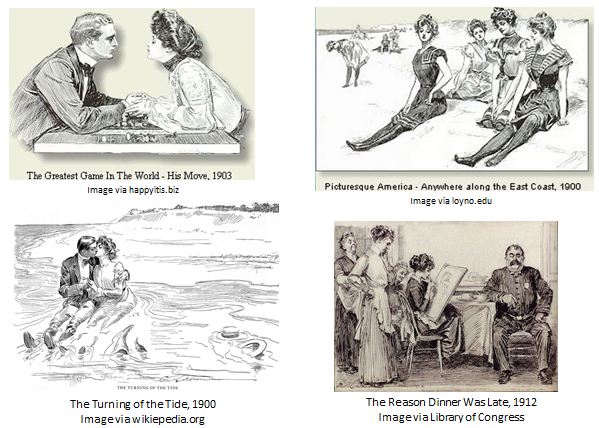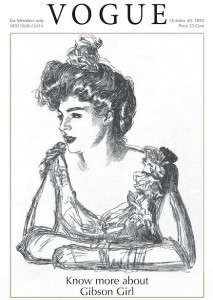
Today’s flashback looks at a popular phenomenon of the late-19th and early-20th centuries, the “Gibson Girl.”
She was the creation of artist Charles Dana Gibson (for a detailed biography, click here), and she was everywhere: in the magazines of Life, Collier’s Weekly, Harper’s, and Scribner’s, to name the major ones. Her look was iconic, and quickly reached beyond the confines of magazine pages, to appear on china plates, spoon medallions, screens, fans, and even wallpaper (for bachelor quarters, according to one source). People would trace and embroider her image on handkerchiefs, too. In terms of her influence on society’s image of women, the Gibson Girl (she had no actual name) has been likened to Barbie, with the two bracketing the beginning and end of the 20th century. (Click here for more on this thread).
The American public was ready for an icon of feminine beauty, charm and accomplishment. Before the appearance of the Gibson Girl, there had been no real defining image of what constituted the ideal American woman. She was a rather nondescript entity.
But by the turn of the century, American women were taking on more of an influential role in society and their own destiny – some attending college, participating in sports and other physical activities such as bicycling, leading political rallies, founding charitable organizations. Middle class women in particular had time-saving household conveniences, which afforded them increased leisure to read magazines, shop, travel to the seashore, attend concerts, and so on. They became more of a fixture in public life than ever before.
What was the Gibson Girl like? Besides being a tall, slender beauty with luxuriant hair (loosely upswept into a topknot – as if it could come loose at any moment, but doesn’t), and a corset-aided hourglass figure, the Gibson Girl exuded confidence. Golfing, studying, flirting, engaging in hobbies – she performed all with equal parts ease and grace. No wonder most American women of the time sought to emulate her, in both dress and demeanor. Gibson himself called her “the American girl to all the world” (http://www.gibson-girls.com/gibson-3.html). Life described it this way, in 1894:
“Mr. Gibson has a great responsibility on his shoulders, and if he once fully realizes it, it will keep him awake nights. I wonder if he knows that there are thousands of American girls, from Oshkosh to Key West, who are trying to live up to the standard of his girls.” (source: http://indiainkelephant.wordpress.com/2010/12/31/friday-ephemera-its-a-bird-its-a-plane-its-gibson-girl/)
Want to learn more about the Gibson Girl?
American Beauties: Drawings from the Golden Age of Illustration (Library of Congress)
What is the Appeal of the Gibson Girl? by Elizabeth Camden, author
The Gibson Girl: the Ideal Woman of the Early 1900s (EyeWitnesstoHistory.com)
Charles Dana Gibson and the Gibson Girls
American Experience (PBS series): Charles Dana Gibson and “The Gibson Girl”
What do you think of the Gibson Girl? Are there any ideals of feminine beauty and character today which resonate in our culture? I’d love to hear from you!
Until next time,
Kathy






I want that hairdo!
Be careful what you wish for, Nancy, LOL!
I’ve heard of her! I’ve seen several pics too. It hurts to even look at that waist. It’s the size of a forearm! It sounds like the Gibson girl was indeed their era’s Barbie.
Fascinating stuff, Kathy!
I can’t imagine how it felt to be cinched like that, LOL. Thanks, Julie!
Good post. I like the Vogue cover because she is exhibiting what was considered daring posture at the time — elbows on the table and leaning forward, forbidden in the Victorian age.
Anything looking like confidence was daring, right? Thanks for stopping by, Jan!
I love this! Pre-cursor to Barbie definitely. It’s fascinating to see that people were challening this high ideal of beauty even at that time, and that people were wondering what it was doing to their daughters’ self-image. I also can’t help thinking of Coco Chanel, who came along not long after this and challenged all these ideals with her loose, corset-less clothing that allowed women freedom. Great flashback!
Thanks so much, Leslie! Love your blog, btw.
I’m bookmarking this post, Kathy. It offers lots of good info for my early 20th century stories. the Gibson Girl was also much prettier than the original Barbie, but I’m sure the character for Barbie was drawn from the Gibson Girl. Great post. Thanks.
Thanks, Marcia!
Ha! Once, in a former life, when I was to attend a black tie event I called a hair salon and made an appointment to have my hair styled in a chignon. When I got there (3hours before said event) they said they didn’t do chignons but could do a Gibson Girl. The hairdresser set to work and after much ratting and spraying and finishing coat of shellac (truth!) she spun me around to see the finished product. I looked as though a UFO had landed on my head!
That must have been interesting! Thanks for the visit, Liza!
I always thought she was a person!! go figure – a figment of someone’s imagination. thanks for the info
Thanks, Louise!
Hey Kathy,
Right now I’m writing in the 20s, but Gibson Girl gives me a keen insight into the time preceding the flapper. Very cool. Thanks for the links!